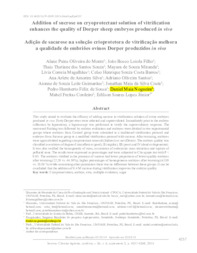Addition of sucrose on cryoprotectant solution of vitrification enhances the quality of Dorper sheep embryos produced in vivo.
Addition of sucrose on cryoprotectant solution of vitrification enhances the quality of Dorper sheep embryos produced in vivo.
Author(s): MONTE, A. P. O. do; LOIOLA FILHO, J. B.; SOUZA, T. T. dos S.; MIRANDA, M. de S.; MAGALHÃES, L. C.; BARROS, C. H. S. C.; SILVA, A. A. de A.; SANTOS, A. O.; GUIMARÃES, A. de S. L.; COSTA, J. M. da S.; SOUSA, P. H. F. de; NOGUEIRA, D. M.; CORDEIRO, M. F.; LOPES JÚNIOR, E. S.
Summary: This study aimed to evaluate the efficacy of adding sucrose in vitrification solution of ovine embryos produced in vivo. Forty Dorper ewes were selected and superovulated. Immediately prior to the embryo collection by laparotomy, a laparoscopy was erformed to verify the superovulatory response. The recovered flushing was followed by embryo evaluation and embryos were divided in two experimental groups where embryos from Control group were submitted to a traditional vitrification protocol and embryos from ucrose group to a modified vitrification protocol with sucrose. After warming, embryos were again divided regarding cryoprotectant removal (Indirect) or not (Direct). The embryo quality was classified as embryos of degrees I (excellent or good), II (regular), III (poor) and IV (dead or degenerate). It was also verified the homogeneity of mass, occurrence of embryonic mass retraction and rupture of pellucid zone. The results were expressed as percentages and were subjected to Chi-square test with P < 0.05. The embryos vitrified in the presence of sucrose had lower proportions of lower-quality embryos after warming (22.20 vs. 44.50%), higher percentages of homogeneous embryos after warming (63.89 vs. 38.89 %) while concerning other parameters there was no difference between these groups. It can be concluded that the addition of 0.4 M sucrose during vitrification improves the embryo quality.
Publication year: 2015
Types of publication: Journal article
Unit: Embrapa Semi-arid Region
Observation
Some of Embrapa's publications are published as ePub files. To read them, use or download one of the following free software options to your computer or mobile device. Android: Google Play Books; IOS: iBooks; Windows and Linux: Calibre.
Access other publications
Access the Agricultural Research Database (BDPA) to consult Embrapa's full library collection and records.
Visit Embrapa Bookstore to purchase books and other publications sold by Embrapa.

